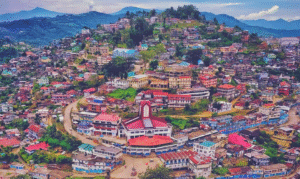Assamese cuisine is more than just a meal; it’s a gateway to a culture, a tradition, and a way of life. Assam is home to fresh-grown fragrant herbs, mustard, rice, and vegetables. A symphony of textures bursts on the tongue as one explores the many dishes of Assamese-speaking people.
From the fluffy embrace of rice, the tangy bite of fermented vegetables, and the fiery chilies, Assamese culture is truly versatile when it comes to food. Age-old recipes, locally discovered flavors, and unique ingredients showcase their love for food. Its recipes are known for being easygoing.
Assamese use age-old recipes and ways of preparing their food which is a direct reflection of their rich cultural heritage.
Located in the fertile lands of Northeast India, Assam cradles a culinary landscape far removed from the mainstream Indian palate. Every dish tells a story of the land, its people, and their enduring connection with nature.
An Ode to History
The hospitable nature of Assamese simmers with the warmth of sharing a table with loved ones. The Dhekhi rice is pounded rhythmically to produce rice flour. The Assamese loves to build a smoky charm by cooking over a wood fire. These activities bring them closeness to their culture and their past. They give out a testament to their land, the ingenuity of its people, and a whispered invitation to dive into a culinary oasis unlike another.
The everyday markets swarming with fresh produce, fragrant spices, and unique local ingredients set the scene to experience an Assamese household Kitchen.
Assamese cuisine comes with an open mind and a curious palate. Each bite is a discovery, a chance to connect with a land and its people through the universal language of food. Every season has a new favorite; every festival brings out new delicacies.
Spices
Unlike its fiery southern counterpart, Assamese cuisine uses spices with nuance and restraint. They try to bring in the natural aroma and taste of their main element. Ginger, garlic, chilies, and panch phoron form the aromatic base of their everyday food. They add warmth and depth without overwhelming the palate.
But Assamese cuisine also boasts its unique players: the citrusy zest of tenga lemon, the earthy musk of black pepper, and the floral aroma of tejpatta (bay leaf) and haldi intertwines their magic into every dish.
Jolpan

Jolpan or breakfast are of many types. Doi chira (They are served with the infamous laal saah(Red Tea) is commonly served by the locals. Other Jolpans are pitha, bora saul, or tekeli pitha.
Rice, the Undisputed King
Rice is significantly the most significantly grown crop in Assam, making it a staple in Assamese houses. In this fertile land, rice reigns supreme. It’s not just a starch, but the soul of every meal. No meal is complete without steamed fragrant joha rice. Served with Spicy masoor dal and smoked pork fat (laru), fish cooked in a tangy (tenga)broth, and the earthy tones of mashed potatoes (aloo pitika) add a comforting touch.
Sticky rice or Bora saul is one other dish that sets them apart from the rest.
Exploring Beyond the Curry
Assamese cuisine is not solely defined by its delectable curries. Delve into the true essence of this regional gastronomy, where the magic lies in the artful interplay of textures and flavors. Beyond the tantalizing curries, Assamese culinary delights unfold a world of culinary exploration, inviting you to savor the nuanced tastes that characterize this rich and diverse cuisine. Mashed lentils (dal)
Locally grown leafy greens (saag) are tempered with mustard oil and panch phoron (a combination of five spices). The humble banana flower takes center stage in dishes like alu thor.
Fermented Foods
There are many benefits to having fermented food. It is great for our gut health and digestion and sustains a healthy metabolism. Assamese cuisine embraces fermentation religiously like most Asian nations.
- Mashed vegetables like tenga (sour) and pitika (mashed) undergo controlled fermentation, adding a unique tang and depth of flavor that distinguishes the regional palate.
- Poita bhaat or fermented rice is a comfort food of the locals. Cooked rice, soaked overnight acts as a cooling element to beat the summer.
- Panch khatta, a five-ingredient fermented condiment, brings a burst of flavor to any dish.
- Khar, a potent alkaline liquid made from banana peels, acts as a natural leavening agent and adds a unique twist to dishes like kharalu (vegetable salad) and tenga fish.
Fish
Assam is a land crisscrossed by rivers and tributaries. Fresh fish is available in abundance. Bhetki (barramundi), maas (carp), and silon (catfish) are cooked in vibrant curries, grilled to smoky perfection, or steamed in banana leaves, retaining their delicate sweetness. Rohu, Hilsa, Borali and Cital are some of the other commonly found fresh produce.
Masor Tenga
The Assamese platter is not complete without its Masor Tenga, a dish that harmonizes diverse flavors, elevating the dining experience through its subtle and intricate combination of ingredients.
Duck
A winter’s favorite is Duck Curry, a revered dish that unfolds its flavors within a rich coconut milk broth, showcasing the culinary prowess of Assamese gastronomy
Desserts
Beyond the savory spectrum, Assamese desserts are surprised by their ingenuity and simplicity. Pithas, delicate rice cakes steamed or fried, come in countless flavors, from jaggery-sweetened jolpan to coconut-infused nalulu. Payas, a creamy rice pudding flavored with cardamom and nuts, offers a comforting finish to any meal.

Conclusion
Assamese cuisines are based upon a basic idea of cooking using locally found resources. Rice, Maize, Potato, Pulses, and Wheat are locally produced food crops. While observing the cuisine, we see how the Assamese people diligently improvise these into their food. The locals have always been creative. Preserving the culture is done in simple but significant ways. These age-old recipes are intertwined in rituals, festivities, and layman greetings to relish these delicacies for many generations to come.
Every festival, occasion, and wedding calls out for intricate recipes. Food is just another way Assamese locals feel a sense of community amongst themselves.
Unravelling a billion untold stories, one chapter at a time, Humans of Northeast takes you on a discovery through vibrant Northeast India – a land rich in people, places, and culture. Ready to immerse yourself in more such stories? Visit our page HONEI to read more about narratives that inspire and uplift.






